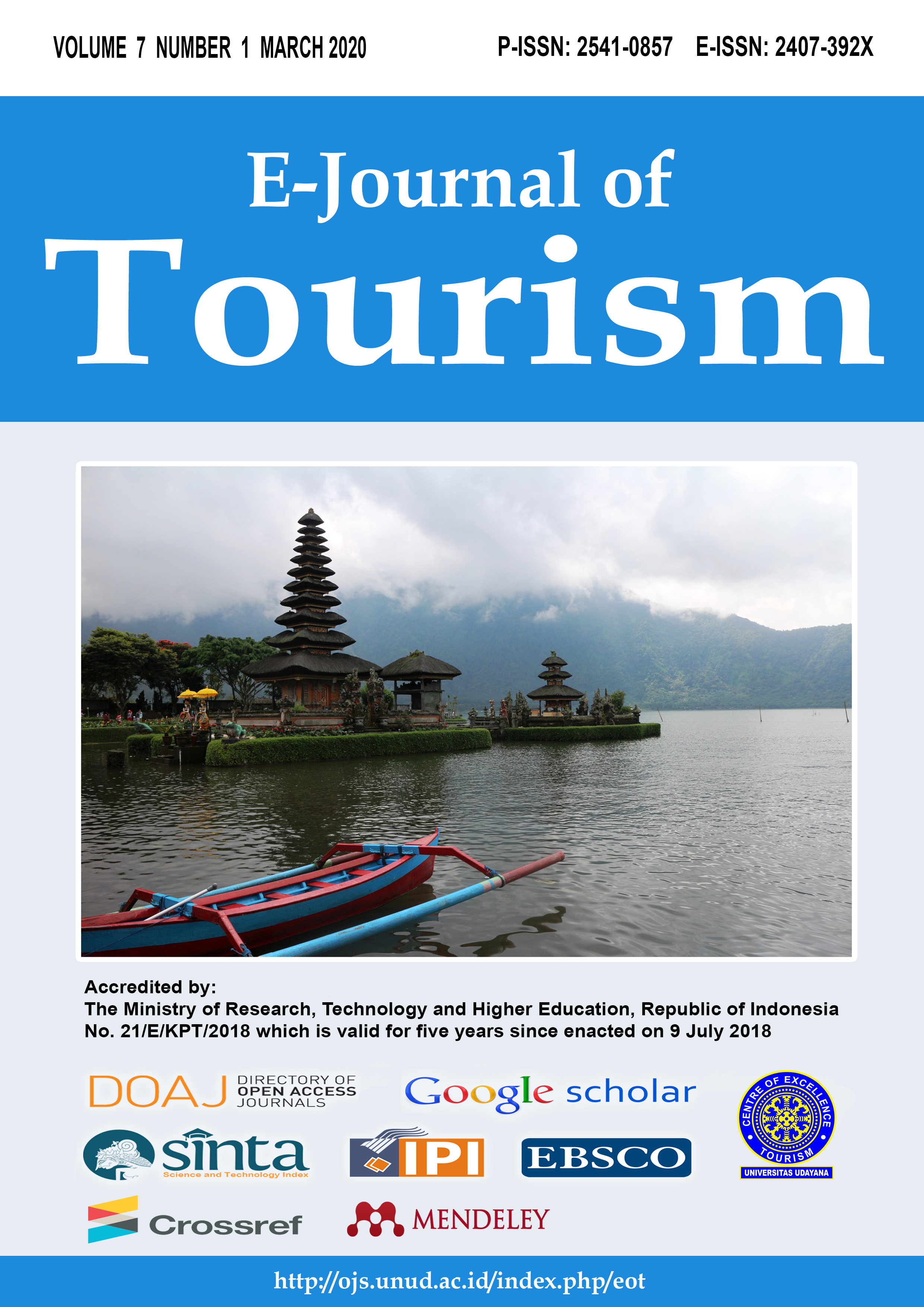Millennial Tourists in Bali: Motivation, Satisfaction and Revisit Intention
Abstract
The Ministry of Tourism of the Republic of Indonesia has developed strategies to attract millennial tourists who are estimated to dominate the world tourism market, where Bali is ranked as the fourth most desirable destination for millennials around the world. One of the important factors for tourists in making a visit decision is motivation. Motivation can affect tourists' satisfaction that is triggered by evaluations through their experiences during a visit and it can affect their revisit intention. Decision making for revisit intention to a destination is actually the behavior of satisfied tourists. This research is a quantitative study with samples of millennial tourists visiting the areas of Ubud, Kuta, Seminyak, Canggu and Uluwatu. Research results were analyzed by Structural Equations Modelling (SEM) analysis usings SmartPLS software 3.0 version. The results showed that motivation consisting of push and pull factors has a significant effect on tourist satisfaction. Tourist satisfaction has a significant effect on the revisit intention. The push factor has a positive but not significant effect on the revisit intention while the pull factor has a significant effect on the revisit intention. Another result showed that 69% of millennial tourists make use of social media as a source of information about Bali. This is also the reason for the facts that 91% of millennial tourists prefer to arrange their own trips.
Keyword : Bali, motivation, satisfaction, revisit intention, millennial tourist.
Downloads
References
Huang,S., Y. Shen., C. Choi. 2015. The Effect of Motivation, Satisfaction and Perceived Value on Tourist Recommendation. Travel and Tourism Research Association: Advancing Tourism Research Globally
Gnanapala, W.K.A.C., A.M.J.A.Dharmasiri and J.A.R.C. Sandaruwani. 2017. Travel Motives, Perception And Satisfaction Of Millennial Travellers: A Study In East Coast Of Sri Lanka. Proceeding 7th International Borneo Business Conference. Page 524-536. Malaysia : Universitas Malaysia Sabah.
Ghozali, I. 2014. Structural Equation Modelling Metode Alternatif dengan Partial Least Square Aplikasi. Cetakan ke empat. Semarang : Universitas Diponegoro
Wiranatha, A.S., I.G.A.O. Suryawardani, I K.G. Bendesa. 2018. Model of Foreign tourist's Loyalty in Cultural and Heritage Tourism. Journal of Global Stochastics Analysis.
Sultan, M.A., T. Haryono, B. Haryanto, A.L. Riani. 2012. Proses Pembentukan Perilaku Niat Wisatawan Berkunjung Kembali. Jurnal Siasat Bisnis Vol 16.
Dayaour, F., & Adongo, C.A. 2015. Why They Go There : International Tourists' Motivation and Revisit Intention to Northern Ghana. American Journal of Tourism Management, 4 (1) : pp 7-17.
Baniya, R., Ghimire, S., & Phuyal, S. 2017. Push and pull factors and their effect on international tourists' revisit intention to Nepal. The Gaze : Journal of Tourism and Hospitality, 8 : pp 20-39.
Khuong, M.N. & Ha H.t.t. 2014. The Influences of Push and Pull Factors on the International Leisure Tourist Return To Ho Chi Minh City, Vietnam – Mediation Analysis of Destination Satisfaction. International Journal of Trade, Economies and Finance, 5 (6) : pp 490-496.

This work is licensed under a Creative Commons Attribution 4.0 International License.
The copyright of the received article shall be assigned to the journal as the publisher of the journal. The intended copyright includes the right to publish the article in various forms (including reprints). The journal maintains the publishing rights to the published articles.




















